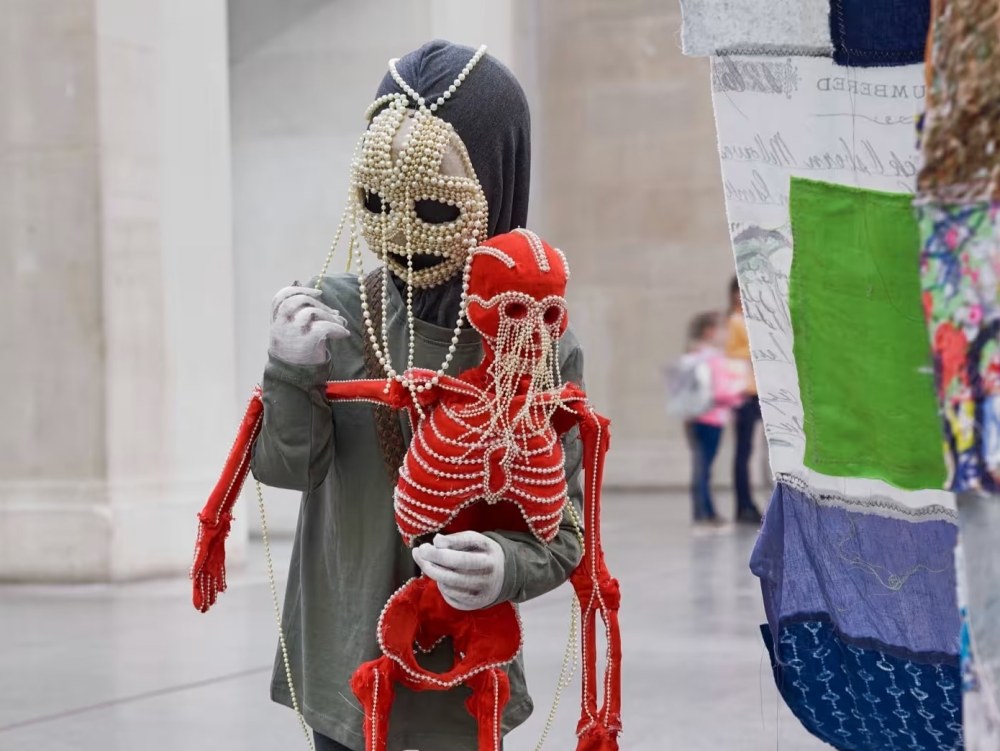
The world of visual arts and design is rich with the exploration of materials, each one telling a unique story and reflecting the cultural zeitgeist. Artists who trace their heritage beyond the shores of the UK have long used lace, weaving and beadwork to highlight different cultures and their social and economic impact. “One of the things that started me on this path was seeing many old and frayed tapestries in the UK and Europe, in fading stately homes, with threads dangling,” says the artist Hew Locke of his relationship with beading. “These were once the most expensive items in the house.”
In his own work, Locke takes what has fallen into disrepair and out of favour and gives it new life. “I use plastic beads, which I originally used to source from five-and-dime stores and Halloween shops,” he says of his practice, in which he transforms these pieces into objects of significance. His handling of beads can be interpreted as celebratory, symbolic and an expression of his Guyanese identity – see his 2022 Tate Britain Duveen commission The Procession. “I am not using them as ‘kitsch’,” he adds of the beads woven into the fabric. “I genuinely like the way they look.”
Victor Ehikhamenor, who featured in the exhibition Rites of Passage that I curated at the Gagosian Gallery in London last spring, also uses beading and lace within his work. “In my art, the lace is not necessarily visible as it is part of a whole,” he says, “buried among other materials like rosary and coral beads. It needs discovering, like you would [find] your parents’ or grandparents’ lace at the bottom of a box. Absent and present at the same time, like colonialism.”
His 2024 work Miracle Central highlights the hope and joy that are connected to the spiritual and religious. The installation, filled with a floating church band and pulpit, conjures memories of white-garment churches, which are a staple in west African communities. Artists such as the photographer Liz Johnson Artur have also documented members of the pentecostal Cherubim & Seraphim church, founded in Nigeria nearly 100 years ago, whose garments often have elements of lace woven into them.
Hamed Maiye, an emerging artist based in London, similarly incorporates lace into his vignettes that evoke the spirit world. When I visited his studio, he reflected on the importance of lace within Nigerian communities; not only does it have a special resonance for the devout, but it is also the material of choice for tailor-made clothes for special occasions. Lace has taken on a particular symbolism for Maiye because his mother sold lace, following in a long tradition of Yoruba women entrepreneurs.
Nengi Omuku, who studied at the Slade School of Fine Art in London, repurposes traditional Yoruba woven fabric such as sanyan – which is a type of aso-oke, the most prestigious fabric in Nigeria. “Using sanyan feels like a reawakening of the culture,” says the Nigerian-born Omuku, “a continued building of a cultural memory, and a way of digging deeper into remembering.” Sanyan serves as a literal canvas for Omuku’s exploration of cultural identity, her figures appearing in beautiful floral compositions. It also offered her, she says, a new lens through which to view herself on her return to her home country from the UK.
Omuku’s commitment to reviving aso-oke weaving, evidenced by her commissioning of cotton spinners in Ilorin and weavers in Lagos State, reflects a profound dedication to preserving cultural heritage and craftsmanship. The revival resonates deeply with fashion designers such as Kenneth Ize and Lisa Folawiyo. Both draw inspiration from indigenous Nigerian textiles, with a particular emphasis on akwete weaving. Akwete, a traditional Igbo textile known for its intricate patterns and vibrant colours, holds a special place in Nigerian heritage. By incorporating akwete into their collections, Ize and Folawiyo pay homage to the rich culture of Nigeria.
What unites these designers and artists is not just a shared appreciation for traditional techniques, but also a commitment to sustainable and ethical fashion practices. By championing indigenous textiles and collaborating directly with local artisans, they empower communities and promote economic development, while ensuring the preservation of traditional crafts. They also inspire us to reconsider the potential of everyday materials. From the bustling streets of Lagos to the galleries of London, their creations serve as reminders of the transformative power of art to evoke emotion, provoke thought and ignite change.